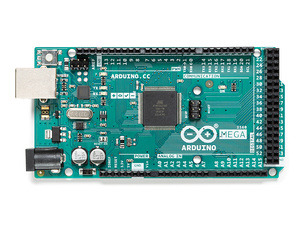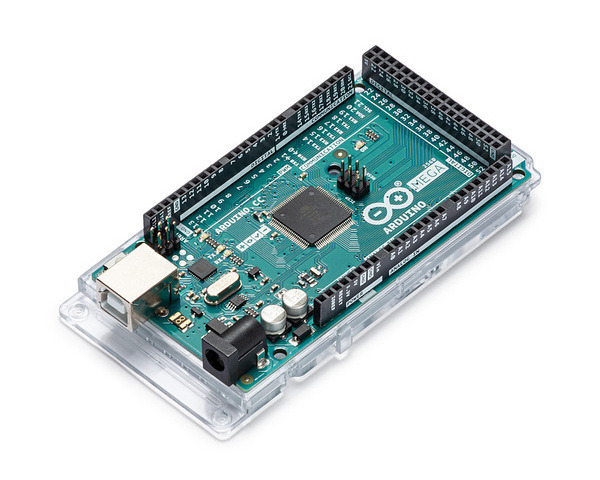Arduino Mega 2560 R3
The Arduino Mega 2560 R3, the successor to the Arduino Mega, is a microcontroller board based on a ATmega2560 AVR microcontroller. It has 70 digital input/output pins (of which 15 can be used as PWM outputs and 16 can be used as analog inputs), a 16 MHz resonator, a USB connection, a power jack, an in-circuit system programming (ICSP) header, and a reset button. The Arduino has an extensive support community, which makes it a very easy way to get started working with embedded electronics.
| Description | Specs (12) | Pictures (3) | Resources (7) | FAQs (0) | On the blog (7) | Distributors (0) |
|---|
Note: This product is manufactured in Italy by affiliates of Arduino Srl, and the product packaging suggests downloading the Arduino IDE from arduino.org. However, we use and recommend using the normal Arduino IDE from arduino.cc, which is the IDE we ensure our Arduino libraries work with.
 |
Overview
The Arduino Mega 2560, the successor to the Arduino Mega, is a microcontroller board based on a ATmega2560 AVR microcontroller. It has 70 digital input/output pins (of which 15 can be used as PWM outputs and 16 can be used as analog inputs), a 16 MHz resonator, a USB connection, a power jack, an in-circuit system programming (ICSP) header, and a reset button. It contains everything needed to support the microcontroller; simply connect it to a computer with a USB cable or power it with a AC-to-DC adapter or battery to get started.
The Mega 2560 differs from the preceding Mega in that it does not use the FTDI USB-to-serial driver chip. Instead, it features an ATmega16U2 programmed as a USB-to-serial converter. This auxiliary microcontroller has its own USB bootloader, which allows advanced users to reprogram it.
The Arduino has a large support community and an extensive set of support libraries and hardware add-on “shields” (e.g. you can easily make your Arduino wireless with our Wixel shield), making it a great introductory platform for embedded electronics.
The Arduino Mega revision R3 adds SDA and SCL pins next to the AREF. In addition, there are two new pins placed near the RESET pin. One is the IOREF that is meant to allow shields to adapt to the voltage provided from the board. The other is a not connected and is reserved for future purposes. The Mega 2560 R3 works with all existing shields but can work with new shields that use these additional pins.
Summary
- Microcontroller: ATmega2560
- Operating voltage: 5 V
- Input voltage (recommended): 7-12 V
- Digital I/O pins: 70 (of which 15 provide PWM output)
- Analog input pins: 16*
- DC current per I/O pin: 40 mA
- DC current for 3.3V pin: 50 mA
- Flash memory: 256 KB of which 8 KB used by bootloader
- SRAM: 8 KB
- EEPROM: 4 KB
- Clock speed: 16 MHz
*The Arduino Mega 2560 has 70 total available I/O lines; all of them can function as digital I/O lines, and sixteen of them can be used as analog inputs.
Warning: We recommend not connecting the Arduino to USB while it is powered through VIN. See this forum post for more information.
More information about the Arduino Mega 2560 is available on Arduino’s website.
Note: The Arduino Mega 2560 does not include a USB cable, batteries, or a DC power adapter. No external programmer is required.


















